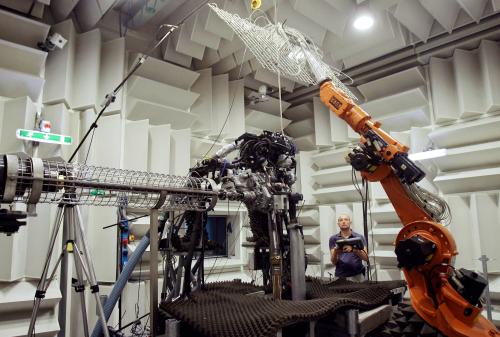Donald Trump entered office on a promise to bring back jobs and lift up the white working-class. While 53 percent of Americans earning less than $30,000 a year voted for Hillary Clinton, the counties she won made up 64 percent of America’s GDP in 2015. Trump, won over five times as many counties as Clinton, but these counties constituted only 36 percent of America’s GDP in 2015.
Trump also surpassed Clinton in places where voters are most at risk of losing their jobs due to automation, and won support among those who had already lost out as a result of technological changes in the workplace. A National Bureau of Economic Research paper found that the more robots introduced in a commuting zone between 1993 and 2007, the more likely the area went to Trump.
However, Trump’s economic message and governance so far has focused almost entirely on job loss due to trade and he has said little on how automation challenges his constituency. On the other hand, Barack Obama warned in his final speech as president that “the next wave of economic dislocation won’t come from overseas. It will come from the relentless pace of automation that makes many good, middle-class jobs obsolete.” In the fall of 2016, the White House released a report on automation that outlined its likely impacts on lower-wage earners and the prospects for deepened wage inequality.
Research from Oxford University predicts 47 percent of jobs are likely to be automated within a decade or two, and a study by the McKinsey Global Institute finds that 46 percent of time spent on existing work activities will become automated. However, when asked about the threat of losing jobs to automation, Secretary Treasury Steve Mnuchin said the issue is “not even on our radar screen… I’m not worried at all.” Not everyone agrees. Larry Summers, who originally argued that automation would help the economy by creating new jobs has since stepped back from this position, warning “This isn’t some future possibility… This is something that’s emerging before us right now.” MIT economist Erik Brynjolfsson concurs: “This is the biggest challenge for our society for the next decade.”
While much has been written on the policy challenges automation poses, little has been written on the political dynamics it is likely to produce. Unsurprisingly, political leaders tend to shy away from discussing the issue. It is difficult to antagonize technological advancement – automation is often the result of corporate investment, it yields growth and achieves efficiency, and average Americans save on products and services as a result. And some make the case that automation is not happening fast enough, citing dismal productivity gains.
The competing theses on the likely effects of automation differ in their understanding of how today’s technological shifts compare to past radical changes in the economy. Nonetheless, policy recommendations that confront technological unemployment can insure against the worst-case scenario. And, as similar disruptions originate from trade and technological improvement, similar policies can ameliorate the consequences of dislocation produced by trade and tech shocks. Pursuing such policies could also present a political opportunity to restore some sober analysis and much-needed non-partisan problem-solving. This would require a response somewhat antithetical to our politics – one that is forward-thinking and anticipates voters’ concerns.
Political solutions that anticipate change
While 65 percent of Americans believe that within 50 years, robots and computers will likely complete work performed by humans today, 80 percent of Americans do not expect their jobs will disappear. While poorer and less-educated Americans demonstrate greater concern for the prospect, American workers overall worry more about displacement by other workers, industry trends, and mismanagement. Given that few voters are preoccupied with disruptive changes to work stability through technological advancements, there exists little incentive for politicians to tackle it.
But doing so provides two important opportunities at a time ripe for political renewal. First, addressing automation upends a politics that relies heavily on antagonism. Unlike trade, few voters reject the benefits of technological change, and automation offers no foreign scapegoats like cheap labor abroad or multilateral trade to accuse of stealing jobs. Subsequently, it is difficult to claim political victories and publically take on opponents. Second, while workers are concerned about more immediate threats, tackling automation would require modernizing the social safety net to not only improve the working lives of Americans today, but also to respond to the changing nature of work itself. As Brookings’ Mark Muro writes, “programs should be anticipatory and offer support when disruption is forecast but not yet hitting home.” This might require openness to challenging some of the premises that have long guided partisan economic platforms.
Because automation is predicted to yield greater economic growth while at the same time displacing many workers, traditional conservatives will have to embrace some degree of government intervention. An inability to adapt conservative economic governance to confront the features of radical shifts in the labor market could prove electorally costly. Americans likely to be the most affected by automation live in Republican districts, but in areas that have experienced the greatest shocks from automation, the 2016 presidential vote was closer. This presents an opportunity for Democrats to contend for the support of these voters. If Democrats fail to address these voters’ needs, the party might miss an opportunity to reassert a strong economic message and reconnect with a working class base.
An opportunity and a cost
Joseph Parilla and Mark Muro have suggested the creation of a Universal Basic Adjustment Benefit to tackle the dislocation likely to become an increasingly routine feature of the labor market. Inspired by calls for a Universal Basic Income (UBI), the adjustment would include job-search counseling, worker training funding, relocation grants, and wage insurance. Given that UBI has attracted support from a group of odd bedfellows that includes American Enterprise Institute’s Charles Murray and Andy Stern, the former president of the Service Employees International Union, a Basic Adjustment Benefit might be able to generate similar cross-ideological interest. In fact, it might even prove more palatable than UBI proposals as the benefit would target moving workers back into the labor market and would combine many welfare programs that could be administered flexibly at the local level.
The consequences of failing to incorporate automation into our political dialogue are potentially high. In the Midwest, manufacturing job loss bred feelings of economic frustration that led many to favor a populist candidate who gave them something to blame, which exemplifies the frustrations likely to take hold as the threat of technological unemployment mounts. Additionally, many of the jobs expected to disappear as a result of automation are held by white males without college educations, a group Trump won handily. Without efforts to ensure workers without a college degree can participate in the economy of the automated era, the growing education divide producing the kind of populist backlash here and across the west is likely to deepen.
The Brookings Institution is committed to quality, independence, and impact.
We are supported by a diverse array of funders. In line with our values and policies, each Brookings publication represents the sole views of its author(s).









Commentary
Automation presents a political challenge, but also an opportunity
May 18, 2017